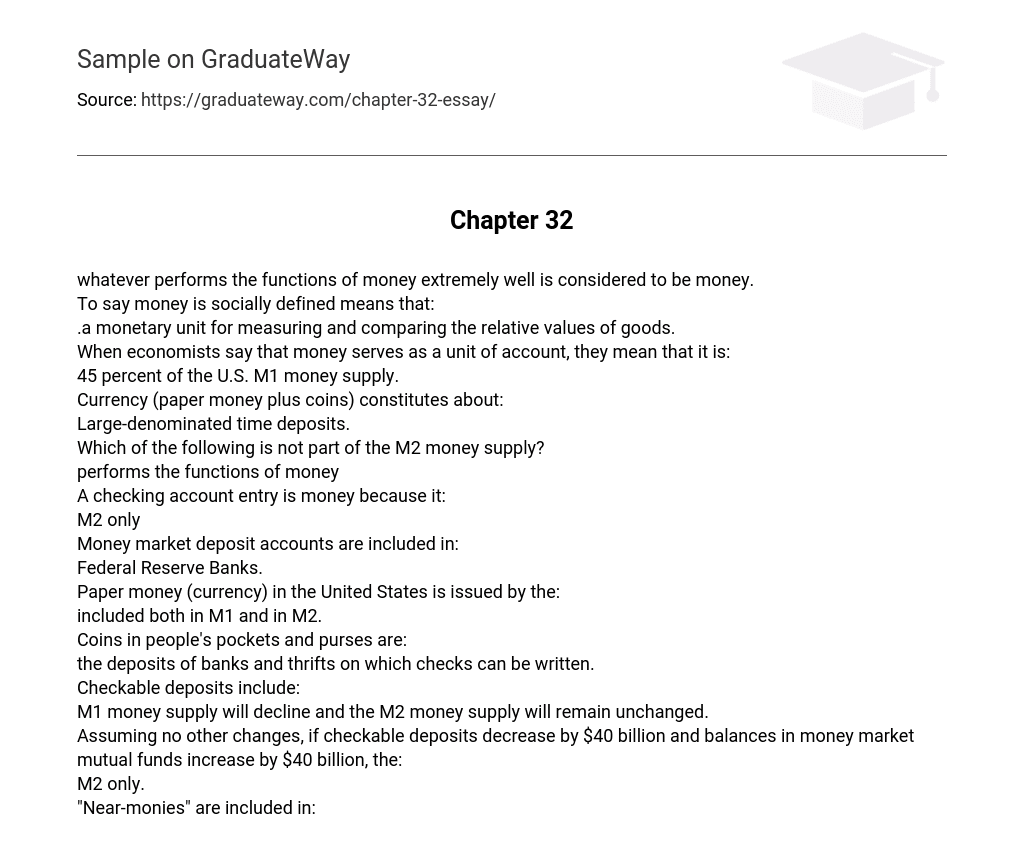whatever performs the functions of money extremely well is considered to be money.
To say money is socially defined means that:
.a monetary unit for measuring and comparing the relative values of goods.
When economists say that money serves as a unit of account, they mean that it is:
45 percent of the U.S. M1 money supply.
Currency (paper money plus coins) constitutes about:
Large-denominated time deposits.
Which of the following is not part of the M2 money supply?
performs the functions of money
A checking account entry is money because it:
M2 only
Money market deposit accounts are included in:
Federal Reserve Banks.
Paper money (currency) in the United States is issued by the:
included both in M1 and in M2.
Coins in people’s pockets and purses are:
the deposits of banks and thrifts on which checks can be written.
Checkable deposits include:
M1 money supply will decline and the M2 money supply will remain unchanged.
Assuming no other changes, if checkable deposits decrease by $40 billion and balances in money market mutual funds increase by $40 billion, the:
M2 only.
“Near-monies” are included in:
M1 and M2 money supplies will not change.
Assuming no other changes, if balances in money market deposit accounts increase by $50 billion and small-denominated time deposits decrease by $50 billion, the:
will fall by 20 percent.
If the price index rises from 200 to 250, the purchasing power value of the dollar:
is the reciprocal of the price level.
The purchasing power of the dollar:
with both fiscal and monetary policy.
Stabilizing a nation’s price level and the purchasing power of its money can be achieved:
Federal Reserve System.
In the U.S. economy, the money supply is controlled by the:
Federal Open Market Committee
As it relates to Federal Reserve activities, the acronym FOMC describes the:
he seven members of the Board of Governors of the Federal Reserve System along with the
president of the New York Federal Reserve Bank and four other Federal Reserve Bank presidents on
a rotating basis.
The Federal Open Market Committee (FOMC) is made up of:
Federal Open Market Committee (FOMC).
The group that sets the Federal Reserve System’s policy on buying and selling government securities
(bills, notes, and bonds) is the:
provide facilities by which commercial banks and thrift institutions may collect checks.
An important routine function of the Federal Reserve Bank is to:
the more independent the central bank, the lower the average annual rate of inflation.
Research for industrially advanced countries indicates that:
the less independent the central bank, the higher the average annual rate of inflation.
Research involving industrially advanced countries suggests that:
have become increasingly similar in recent years.
Commercial banks and thrift institutions:
high-interest-rate loans to home buyers with above-average credit risk
“Subprime mortgage loans” refer to:
they reduced their direct exposure to mortgage default risk but were still exposed through loans to investors in mortgage-backed securities.
When banks bundled mortgage loans and sold the resulting mortgage-backed securities:
insured holders of loan-backed securities in case the underlying loans were not repaid.
Collateralized default swaps:
.the process by which securities exchanges provide credit for personal and business needs apart from traditional bank lending.
The “shadow banking system” refers to:
Merrill Lynch
Which of the following financial institutions was acquired by Bank of America as a result of the
financial crisis of 2007 and 2008?
Moral Hazard
Some economists are concerned that the financial rescue provided by the TARP will encourage
financial investors and firms to take on greater risks in the future. This is an example of:
Lender of last resort.
Which role of the Federal Reserve was expanded directly as a result of the PDCF and TSLF?
Commercial Paper Funding Facility
Which of the following programs involves the Federal Reserve directly purchasing short-term lending
instruments from corporations?
securities firms.
Smith Barney, Charles Schwab, and Merrill Lynch are all primarily:
mutual funds companies.
Firms whose central business is providing individual account shares of a group of stocks, bonds, or
both are known as
Remember! This essay was written by a student
You can get a custom paper by one of our expert writers
Order custom paper
Without paying upfront





